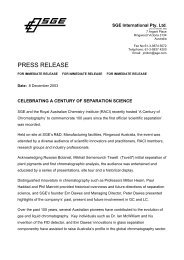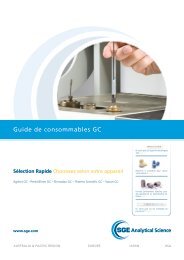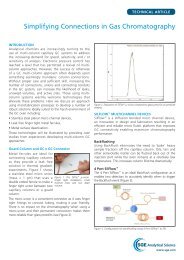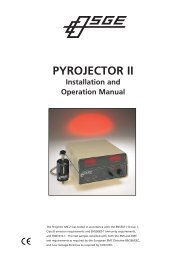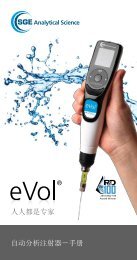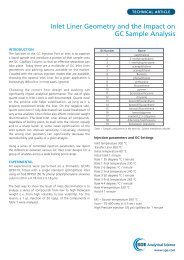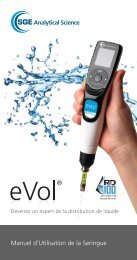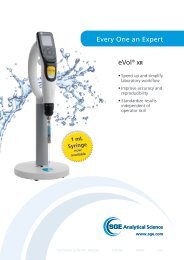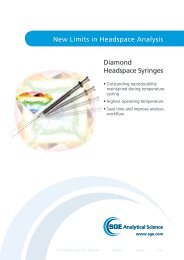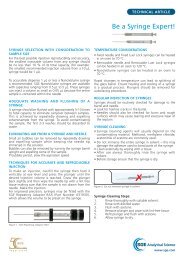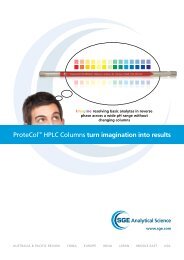ETP Electron Multipliers - Care and Handling - SGE Analytical Science
ETP Electron Multipliers - Care and Handling - SGE Analytical Science
ETP Electron Multipliers - Care and Handling - SGE Analytical Science
Create successful ePaper yourself
Turn your PDF publications into a flip-book with our unique Google optimized e-Paper software.
<strong>Care</strong> <strong>and</strong> H<strong>and</strong>ling<br />
<strong>ETP</strong> ELECTRON<br />
MULTIPLIERS<br />
A division of
Maintenance, Storage,<br />
<strong>and</strong> H<strong>and</strong>ling of<br />
<strong>ETP</strong> <strong>Electron</strong> <strong>Multipliers</strong><br />
<strong>ETP</strong> <strong>Electron</strong> <strong>Multipliers</strong> from <strong>SGE</strong> are incorporated as<br />
original equipment in all areas of mass spectrometry<br />
<strong>and</strong> surface science, as well as a diverse range of<br />
analytical <strong>and</strong> general physics applications. They offer<br />
the higher performance required by modern<br />
instrumentation <strong>and</strong> have a proven reputation for reliability,<br />
ruggedness, <strong>and</strong> performance.<br />
This booklet provides informaton on the maintenance,<br />
storage, <strong>and</strong> h<strong>and</strong>ling of <strong>ETP</strong> <strong>Electron</strong> <strong>Multipliers</strong>.<br />
Following the basic procedures described herein will enable<br />
you to obtain the optimum life <strong>and</strong> performance from your<br />
<strong>ETP</strong> <strong>Electron</strong> Multiplier.<br />
www.sge.com/etp<br />
i
ii<br />
CONTENTS:<br />
Title Pg<br />
Storage of <strong>ETP</strong> <strong>Electron</strong> <strong>Multipliers</strong> 1<br />
<strong>Care</strong> <strong>and</strong> H<strong>and</strong>ling of<br />
<strong>ETP</strong> <strong>Electron</strong> <strong>Multipliers</strong> 2<br />
Cleaning <strong>ETP</strong> <strong>Electron</strong> <strong>Multipliers</strong> 3<br />
Installing <strong>and</strong> Operating<br />
<strong>ETP</strong> <strong>Electron</strong> <strong>Multipliers</strong> 5<br />
Obtaining Optimum Lifetime from<br />
<strong>ETP</strong> <strong>Electron</strong> <strong>Multipliers</strong> 6<br />
www.sge.com/etp
Storage of<br />
<strong>ETP</strong> <strong>Electron</strong> <strong>Multipliers</strong><br />
The critical dynode surfaces of an <strong>ETP</strong> <strong>Electron</strong> Multiplier<br />
consist of a specially formulated <strong>and</strong> applied aluminum<br />
oxide material, which is very rugged <strong>and</strong> completely stable,<br />
even when repeatedly exposed to room atmosphere.<br />
The original packing supplied by <strong>ETP</strong> is designed for<br />
long term storage. The multiplier is enclosed in two sealed<br />
plastic bags. The outer bag contains a silica gel package<br />
to minimize adsorption of moisture, which could otherwise<br />
lead to excessive outgassing upon installation.<br />
Contained in its original packaging, the shelf-life of an<br />
<strong>ETP</strong> <strong>Electron</strong> Multiplier is guaranteed for up to two years<br />
from the date of shipment. If it is necessary to store the<br />
multiplier outside its original packaging, it should be kept<br />
in a clean, dust-free, low-humidity environment, such as a<br />
glass desiccator.<br />
www.sge.com/etp<br />
1
<strong>Care</strong> <strong>and</strong> H<strong>and</strong>ling of<br />
<strong>ETP</strong> <strong>Electron</strong> <strong>Multipliers</strong><br />
In order to minimize contamination, st<strong>and</strong>ard high-vacuum<br />
techniques are recommended when h<strong>and</strong>ling <strong>ETP</strong> <strong>Electron</strong><br />
<strong>Multipliers</strong>. Clean, powder-free gloves or finger cots<br />
should be worn to prevent the transfer of skin oils to<br />
critical or mounting surfaces of the multiplier. All tools,<br />
mountings, <strong>and</strong> equipment should be thoroughly cleaned<br />
prior to coming in contact with the multiplier.<br />
<strong>Care</strong> should also be taken to minimize exposure of the<br />
multiplier to dust or other airborne contamination.<br />
Dust particles within the detector may result in increased<br />
background noise during operation.<br />
Exposure of the multiplier to high humidity should be<br />
avoided in order to minimize outgassing during initial<br />
operation. If the multiplier exhibits excessive noise due<br />
to adsorbed moisture, this condition may be rectified by<br />
either leaving the multiplier in high vacuum for about 24<br />
hours, or by using a simple vacuum bake procedure.<br />
2<br />
www.sge.com/etp
NOTE: Most models may be baked in vacuum at up to<br />
350˚C. Some models may not be baked above 100˚C.<br />
For information concerning temperature limitations, refer<br />
to the installation notes supplied with each <strong>ETP</strong> <strong>Electron</strong><br />
Multiplier.<br />
If baking must be done in atmosphere, the temperature<br />
must be limited to 120°C (or lower than 100°C for some<br />
models – see Note above). The multiplier should be heated<br />
<strong>and</strong> cooled slowly to avoid damage due to thermal shock.<br />
The rugged design of <strong>ETP</strong> <strong>Electron</strong> <strong>Multipliers</strong> reduces the<br />
risk of damage during h<strong>and</strong>ling, however, an electron<br />
multiplier is a precision component, <strong>and</strong> all reasonable care<br />
should be used when installing or removing.<br />
Cleaning <strong>ETP</strong> <strong>Electron</strong><br />
<strong>Multipliers</strong><br />
In normal operation it is not recommended to clean the<br />
multiplier in any way. However, if the multiplier becomes<br />
contaminated (eg. as a result of vacuum system failure)<br />
then it may be possible to clean the multiplier.<br />
Caution: DO NOT operate an electron multiplier suspected<br />
of being contaminated until it has first been cleaned as<br />
described overleaf. Operation of a contaminated multiplier<br />
will permanently damage the critical surfaces.<br />
www.sge.com/etp<br />
3
Not all <strong>ETP</strong> <strong>Electron</strong> Multiplier models can be cleaned using<br />
an ultra-sonic cleaner. Check with <strong>SGE</strong> technical support<br />
to determine if your model multiplier can be cleaned.<br />
If your multiplier can be cleaned, then non-polar solvents<br />
must be used. (Heptane is a non-polar solvent).<br />
The following is the only procedure approved by <strong>SGE</strong>:<br />
Cleaning Equipment<br />
1. Ultra-sonic cleaner<br />
2. Clean glass beaker (100mL or larger)<br />
3. AR- or HPLC-grade Heptane solvent<br />
Cleaning Method *<br />
1. Place the multiplier in the beaker <strong>and</strong> fill with<br />
Heptane until multiplier is fully immersed.<br />
2. Place the beaker in the ultra-sonic cleaner <strong>and</strong><br />
clean for approximately ten minutes.<br />
3. Dispose of solvent in an appropriate manner <strong>and</strong><br />
refill the beaker.<br />
4. Repeat steps 1-3 a further 2 times.<br />
5. Remove the multiplier from the beaker <strong>and</strong> allow<br />
to dry at room temperature.<br />
6. Bake the multiplier for three hours in air at 100°C.<br />
*Check with <strong>SGE</strong> technical support before proceeding.<br />
4 www.sge.com/etp
Installing <strong>and</strong> Operating<br />
<strong>ETP</strong> <strong>Electron</strong> <strong>Multipliers</strong><br />
<strong>ETP</strong> <strong>Electron</strong> <strong>Multipliers</strong> generally require no<br />
preconditioning, however, when first installed, it is<br />
recommended that applied voltage not exceed 2200V<br />
for the first 24 hours of operation. For fast Time-Of-Flight<br />
multipliers with model numbers between 14870 <strong>and</strong><br />
14899, the voltage limit is 3200V.<br />
Multiplier leads should be positioned for a minimum<br />
clearance of 3mm between any lead <strong>and</strong> any other part<br />
of the multiplier mount or vacuum chamber.<br />
The multiplier should be mounted so that there are no<br />
sharp objects in close proximity to the entrance aperture.<br />
This condition could result in noise during operation.<br />
Operating pressure should be as low as possible for best<br />
lifetime <strong>and</strong> minimum noise. To avoid risk of damage<br />
due to discharge or arcing, the multiplier should not be<br />
operated at a pressure in excess of 1x10-4 mbar X.<br />
www.sge.com/etp<br />
5
6<br />
Obtaining Optimum Lifetime<br />
from <strong>ETP</strong> <strong>Electron</strong> <strong>Multipliers</strong><br />
The gain of a correctly installed electron multiplier will<br />
fall very gradually over time, requiring the applied voltage<br />
to be periodically increased. This is a normal part of the<br />
multiplier aging process. Total operational life varies<br />
depending on application <strong>and</strong> may be affected by a<br />
number of factors:<br />
Operating Environment:<br />
Lower operating pressure <strong>and</strong> lower partial pressure of<br />
hydrocarbons in the vacuum chamber will result in<br />
increased operational life, all other conditions remaining<br />
the same.<br />
Operating Gain:<br />
Operation should always be at the lowest applied voltage<br />
consistent with good signal acquisition. In general, the<br />
lower the gain, the longer the life of the multiplier.<br />
www.sge.com/etp
Output Current:<br />
Multiplier lifetime is inversely proportional to average<br />
output current. Excessive input signals should be avoided,<br />
especially when operating at high gain.<br />
Rapid degradation of multiplier performance may result<br />
from failure of the vacuum pumping system. This may<br />
result in severe contamination of the detector or damage<br />
due to arcing caused by the sudden increase in chamber<br />
pressure. If vacuum failure occurs, the multiplier should be<br />
cleaned before being operated again. Degradation caused<br />
by vacuum failure may be permanent <strong>and</strong> irreversible,<br />
especially if the multiplier high voltage was ON during the<br />
vacuum failure.<br />
NOTE: Due to the wide variety of applications <strong>and</strong><br />
environmental conditions within instruments, there is<br />
no warranty on the operational lifetime of any electron<br />
multiplier.<br />
For technical or ordering information contact your nearest<br />
<strong>ETP</strong> or <strong>SGE</strong> office or visit www.sge.com/etp<br />
www.sge.com/etp 7
USA<br />
<strong>SGE</strong>, Incorporated<br />
2007 Kramer Lane,<br />
Austin, Texas, 78758, USA<br />
Toll Free: 800 945 6154<br />
Tel: +1 512 837 7190<br />
Fax: +1 512 836 9159<br />
E-mail: usa@sge.com<br />
AUSTRALIA AND PACIFIC REGION<br />
<strong>SGE</strong> <strong>Analytical</strong> <strong>Science</strong> Pty. Ltd<br />
7 Argent Place,<br />
Ringwood, VIC 3134, Australia<br />
Tel: +61 (0) 3 9837 4200<br />
Fax: +61 (0) 3 9874 5672<br />
E-mail: support@sge.com<br />
EUROPE<br />
<strong>SGE</strong> Europe Ltd. (UK)<br />
1 Potters Lane, Kiln Farm,<br />
Milton Keynes, MK11 3LA, UK<br />
Tel: +44 (0) 1908 568844<br />
Fax: +44 (0) 1908 566790<br />
E-mail: uk@sge.com<br />
Visit www.sge.com/etp for technical information<br />
<strong>and</strong> on-line training on <strong>ETP</strong> <strong>Electron</strong> <strong>Multipliers</strong><br />
©Copyright 2006 <strong>SGE</strong> <strong>Analytical</strong> <strong>Science</strong> Pty. Ltd.<br />
All rights reserved BR-0061-A Rev 14 06/07





